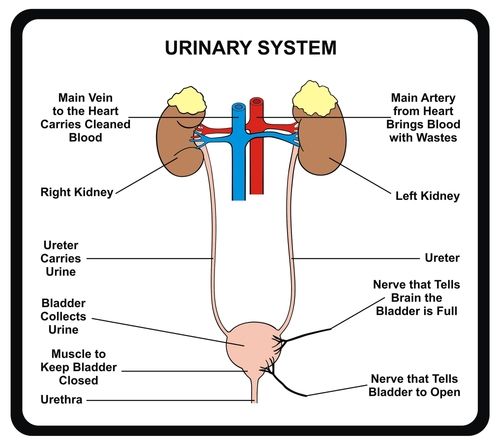Filtration And Waste Elimination From Urinary System Explained

The urinary system is responsible for regulating the body’s fluid balance and eliminating waste products from the body. It is composed of the kidneys, ureters, bladder, and urethra.
The kidneys are the primary organs of the urinary system, responsible for filtering the blood and producing urine. Understanding the anatomy and function of the urinary system is crucial for maintaining a healthy body.
The filtration process within the kidneys involves the removal of waste products such as urea and excess water from the bloodstream. This process is vital in maintaining the body’s homeostasis, as the accumulation of waste products can lead to various health complications.
Once the urine is produced in the kidneys, it travels through the ureters to the bladder where it is stored until it is eliminated from the body through the urethra.
Despite its importance, the urinary system can be prone to various disorders and diseases. Therefore, it is essential to maintain a healthy urinary system through proper hydration and regular check-ups with a healthcare professional.
Key Takeaways
- The kidneys filter blood and produce urine through a process that occurs in nephrons.
- Ureters are muscular tubes that propel urine from kidneys to the bladder.
- The bladder is a hollow muscular sac that can hold up to 600 ml of urine and is controlled by the autonomic nervous system and brain.
- Urinary tract infections, kidney stones, and urinary incontinence are common conditions that can affect the urinary system, and treatment options vary depending on the cause and severity of the condition.
Anatomy of the Urinary System
The anatomical structure of the urinary system encompasses the kidneys, ureters, bladder, and urethra. The kidneys are a pair of bean-shaped organs located on either side of the spine, just below the ribcage. They play a vital role in maintaining the body’s homeostasis by filtering the blood and removing waste products, excess water, and electrolytes.
The ureters are two narrow tubes that connect the kidneys to the bladder. They transport urine from the kidneys to the bladder, where it is stored until it is eliminated from the body.
The bladder is a hollow muscular sac located in the pelvis that can hold up to 600 ml of urine. The bladder’s muscular walls contract and relax, allowing urine to be stored and eliminated from the body.
The urethra is a narrow tube that extends from the bladder to the outside of the body. It plays a crucial role in eliminating urine from the body. In males, the urethra also serves as the passage for semen during ejaculation.
Understanding the anatomy of the urinary system is essential in comprehending the filtration and waste elimination processes that occur within the body.
The Role of the Kidneys in Filtration
One of the vital functions of the kidneys is their ability to separate useful substances from waste products in the blood. This is achieved through a complex process called filtration, which takes place in the nephrons, the functional units of the kidneys. Each kidney contains about one million nephrons, which are responsible for filtering about 120-150 liters of blood every day.
During filtration, blood enters the nephron through a cluster of tiny blood vessels called the glomerulus. The glomerulus acts as a sieve, allowing small molecules such as water, glucose, amino acids, and salts to pass through, while retaining larger molecules such as proteins and blood cells. The filtrate then passes through a series of tubules, where additional substances are reabsorbed back into the bloodstream. Finally, the remaining waste products, such as urea and creatinine, are excreted from the body in the form of urine. The table below summarizes the main components of the filtration process in the kidneys.
| Component | Description | Function |
|---|---|---|
| Glomerulus | Cluster of tiny blood vessels in the nephron | Filters blood, allowing small molecules to pass through while retaining larger molecules |
| Tubules | Series of small tubes in the nephron | Reabsorbs useful substances such as water, glucose, and amino acids back into the bloodstream |
| Filtrate | Fluid that is produced by the glomerulus and travels through the tubules in the nephron | Contains useful substances that have been filtered out of the blood, as well as waste products |
| Urine | Fluid that is excreted from the body through the urethra | Contains waste products such as urea and creatinine, which have been removed from the blood |
The Production of Urine
A crucial step in the process of urine production is the reabsorption of useful substances such as water and glucose back into the bloodstream through the tubules in the nephron. This occurs in the proximal convoluted tubule, where the majority of reabsorption takes place.
The tubule is lined with specialized cells that actively transport certain substances, such as glucose, back into the bloodstream. This allows the body to retain valuable nutrients and maintain a stable internal environment.
However, not all substances are reabsorbed. Some waste products, such as urea and creatinine, continue to pass through the nephron and into the collecting ducts. These waste products are eventually eliminated from the body through the process of urination.
The production of urine is an essential function of the urinary system, allowing the body to rid itself of harmful waste products and maintain a healthy balance of fluids and electrolytes.
Transporting Urine through the Ureters
Ureters are muscular tubes that propel urine from the renal pelvis of each kidney to the urinary bladder. The ureters are approximately 25-30 cm in length and 3-4 mm in diameter, and they are lined with smooth muscle fibers that contract rhythmically to move urine from the kidneys to the bladder. The walls of the ureters contain three layers: an outer adventitia layer, a middle muscular layer, and an inner mucosa layer.
The muscular layer is the thickest layer and is made up of longitudinal and circular smooth muscle fibers that work together to propel urine from the kidneys to the bladder. Transporting urine through the ureters is a complex process that involves both passive and active mechanisms. The ureters rely on gravity and peristalsis to move urine from the renal pelvis to the bladder.
Peristalsis is a series of coordinated contractions and relaxations of the smooth muscle fibers that line the ureters, which helps to push urine along. Additionally, the ureters utilize a specialized valve system that prevents urine from flowing back into the kidneys. This valve system is composed of two muscular valves, one at the junction of the renal pelvis and the ureter and the other at the point where the ureter enters the bladder.
Overall, the ureters play a critical role in the transport of urine from the kidneys to the bladder, and any disruption in their function can result in urinary tract obstruction and other complications.
The Function of the Bladder
The bladder serves as a vital storage reservoir for urine, allowing for controlled elimination that is essential for maintaining proper bodily function. The bladder is located in the lower abdomen and is a muscular sac that can expand and contract to accommodate varying amounts of urine.
The bladder is responsible for holding urine until the body signals that it is time to eliminate waste. The function of the bladder is controlled by the nervous system and muscles that work together to allow for the storage and release of urine.
Here are some key functions of the bladder:
- The bladder allows for the storage of urine until it is convenient and appropriate to eliminate waste.
- When urine enters the bladder, the bladder wall relaxes and expands, allowing for the storage of increasing amounts of urine.
- The bladder wall is made up of smooth muscle that contracts when the bladder is full, signalling the need for elimination.
- The bladder sphincter is a ring of muscle that surrounds the urethra and keeps urine from leaking out until it is time for elimination.
- The bladder is controlled by the autonomic nervous system and the brain, which work together to regulate bladder function, including the storage and release of urine.
Overall, the bladder plays a critical role in the urinary system, allowing for the storage and controlled elimination of urine. By working in concert with other parts of the urinary system, the bladder helps to maintain proper bodily function and eliminate waste products from the body.
The Importance of the Urethra
After understanding the function of the bladder, it is important to delve into the role of the urethra in the urinary system. The urethra is a tubular structure that connects the urinary bladder to the outside of the body. Its primary function is to allow for the elimination of urine from the body. The urethra is an essential part of the urinary system, as it ensures that waste products are efficiently eliminated from the body.
The urethra can be divided into three parts: the prostatic urethra, the membranous urethra, and the spongy or penile urethra. Each of these parts has a distinct role in the process of urine elimination. The prostatic urethra runs through the prostate gland and is surrounded by the internal urethral sphincter, which helps to control the release of urine. The membranous urethra is a short segment that runs through the pelvic floor muscles and is surrounded by the external urethral sphincter, which is under voluntary control. Lastly, the spongy or penile urethra runs through the penis and is surrounded by erectile tissue. Understanding the anatomy of the urethra is crucial to understanding the process of urine elimination and the role the urethra plays in the urinary system.
| Part of the Urethra | Function |
|---|---|
| Prostatic urethra | Runs through the prostate gland and is surrounded by the internal urethral sphincter, which helps to control the release of urine. |
| Membranous urethra | A short segment that runs through the pelvic floor muscles and is surrounded by the external urethral sphincter, which is under voluntary control. |
| Spongy or penile urethra | Runs through the penis and is surrounded by erectile tissue. |
| Internal Urethral Sphincter | Helps to control the release of urine in the prostatic urethra. |
| External Urethral Sphincter | Under voluntary control and surrounds the membranous urethra. |
The urethra plays a crucial role in the urinary system by allowing for the elimination of waste products from the body. The anatomy of the urethra is complex, with three distinct parts, each with a specific function. The internal and external urethral sphincters are also important in controlling the release of urine. Understanding the importance of the urethra is essential in understanding the urinary system as a whole.
Common Urinary System Disorders
Common disorders affecting the urinary system can include infections, kidney stones, and urinary incontinence.
Urinary tract infections (UTIs) are caused by bacteria entering the urinary tract and can affect any part of the urinary system including the bladder, urethra, and kidneys. Symptoms of UTIs include frequent urination, pain or burning during urination, and cloudy or strong-smelling urine. Treatment for UTIs typically involves antibiotics to eliminate the bacteria causing the infection.
Kidney stones are another common disorder of the urinary system. They are formed from crystals that accumulate in the kidneys and can cause severe pain when they pass through the ureters. Risk factors for developing kidney stones include dehydration, a diet high in salt and protein, and certain medical conditions such as gout. Treatment for kidney stones may involve increased fluid intake, medication to manage pain, and in some cases, surgical removal.
Urinary incontinence, or the involuntary loss of urine, is another common urinary system disorder that can affect individuals of all ages. It may be caused by weakened pelvic muscles, nerve damage, or certain medical conditions such as diabetes. Treatment options for urinary incontinence range from pelvic floor exercises to medication and surgery.
Maintaining a Healthy Urinary System
One effective way to maintain a healthy urinary system is by staying hydrated through regular consumption of water and other fluids. This is because water helps to flush out bacteria and other harmful substances from the urinary tract. In addition to this, drinking enough water also helps to dilute urine, reducing the concentration of waste products that may irritate the bladder and lead to urinary tract infections.
Apart from staying hydrated, there are other ways to maintain a healthy urinary system. For instance, practicing good hygiene can help to prevent the spread of bacteria that can cause infections. This involves wiping from front to back after using the toilet, taking showers instead of baths, and wearing clean underwear. It is also important to empty the bladder regularly and completely, and to avoid holding urine in for too long. Other measures that can help to promote urinary tract health include avoiding caffeine and alcohol, exercising regularly, and quitting smoking.
| Tips for Maintaining a Healthy Urinary System | ||||||
|---|---|---|---|---|---|---|
| Stay hydrated | Practice good hygiene | Empty bladder regularly | ||||
| Avoid caffeine and alcohol | Exercise regularly | Quit smoking | Eat a balanced diet | Manage stress levels | Seek medical attention if experiencing symptoms |
Conclusion
The urinary system is a vital aspect of human anatomy that helps in eliminating waste from the body. The kidneys play a crucial role in filtering blood and removing waste products, which are then passed out of the body in the form of urine.
The ureters transport urine to the bladder, which stores the urine until it is expelled through the urethra. However, several disorders can affect the functioning of the urinary system, including urinary tract infections, kidney stones, and bladder cancer.
To maintain a healthy urinary system, it is essential to drink plenty of water, avoid holding urine for extended periods, and practice good hygiene. Additionally, individuals should consume a balanced diet and avoid smoking and excessive alcohol consumption.
If symptoms of a urinary system disorder occur, individuals should seek medical attention promptly. Overall, understanding the anatomy and functioning of the urinary system is crucial in maintaining optimal health and preventing potential complications.








